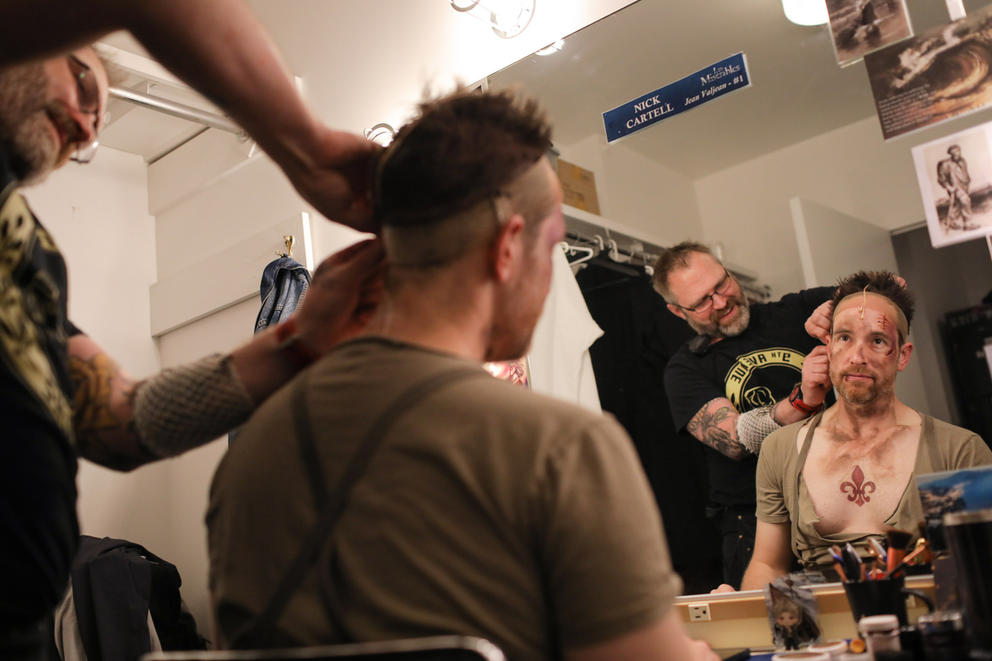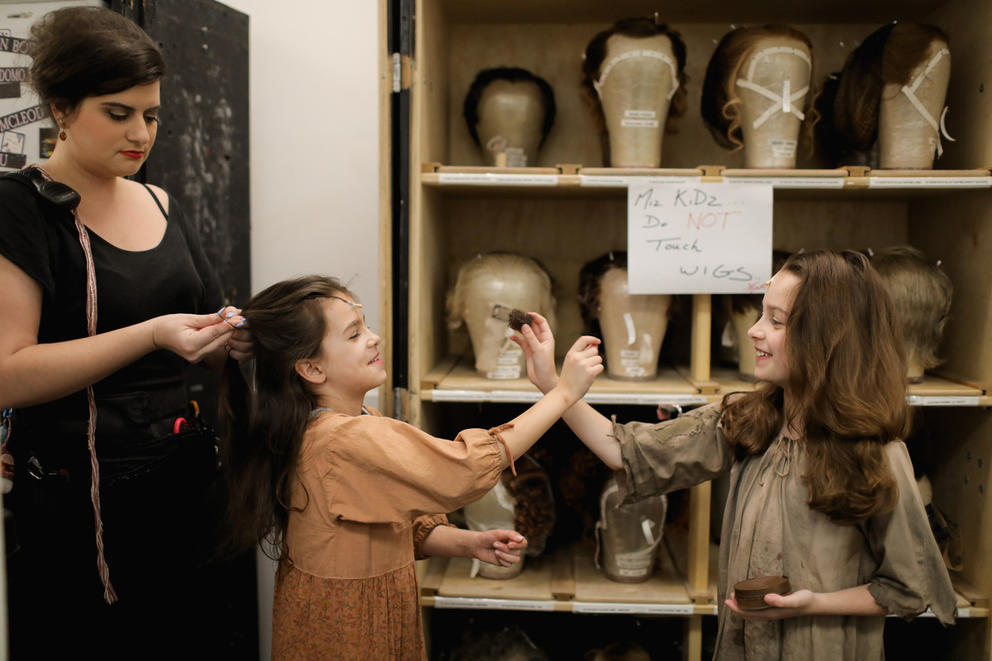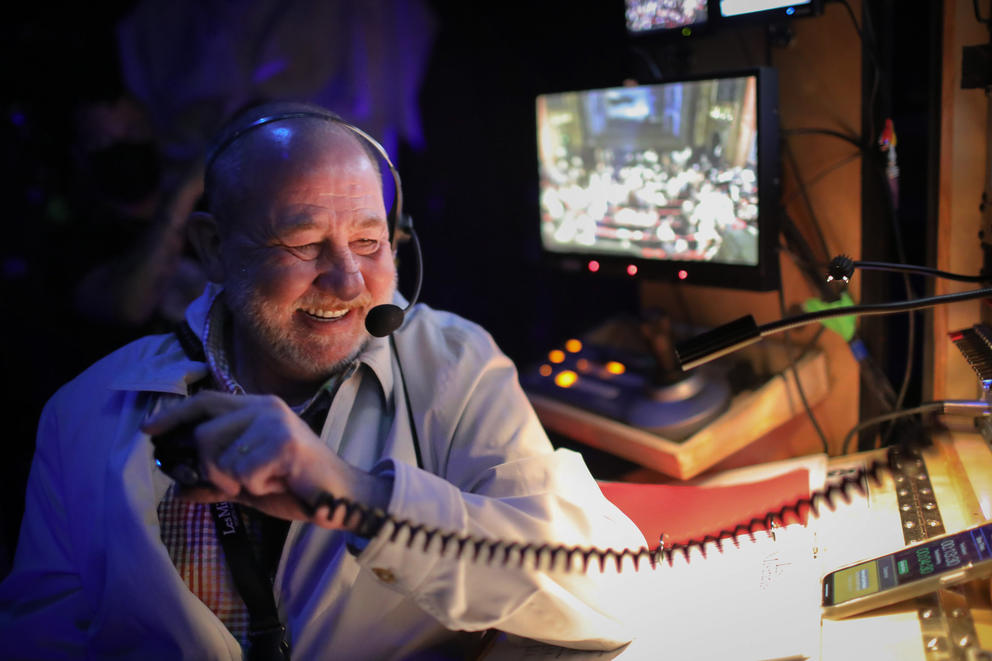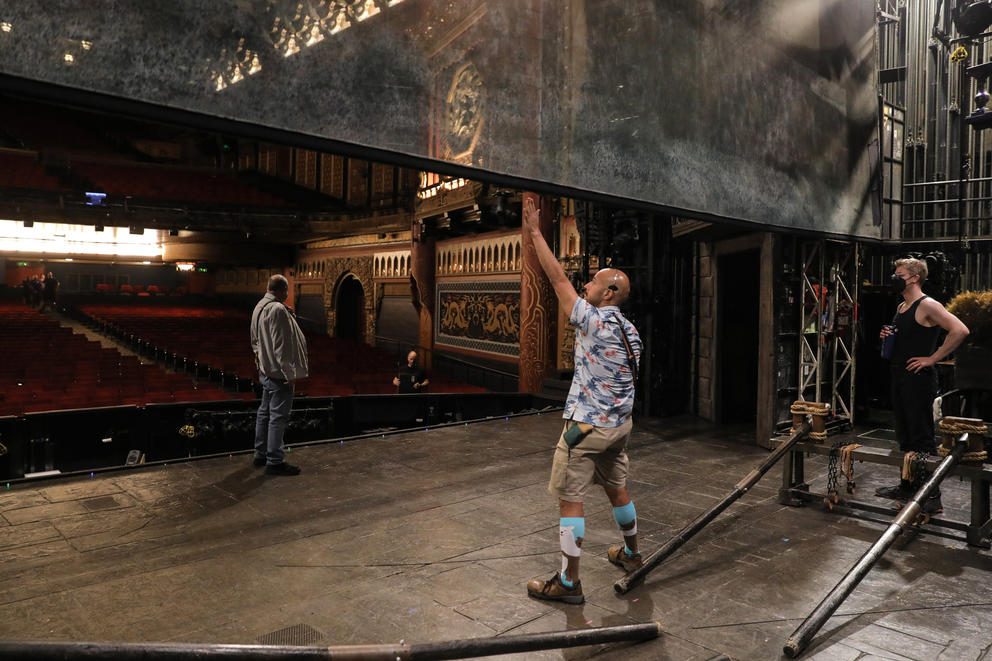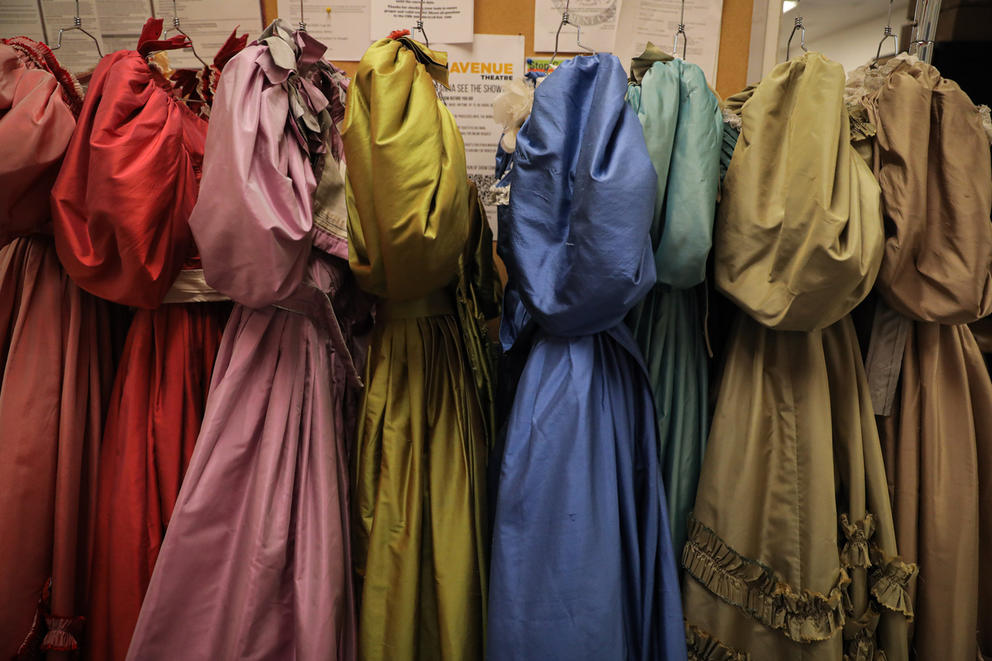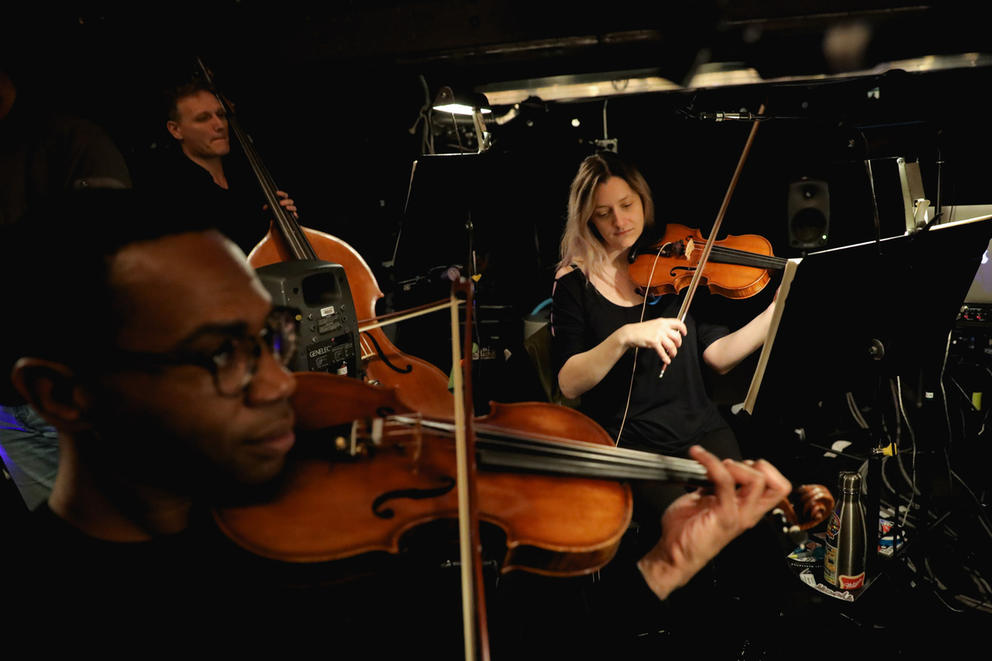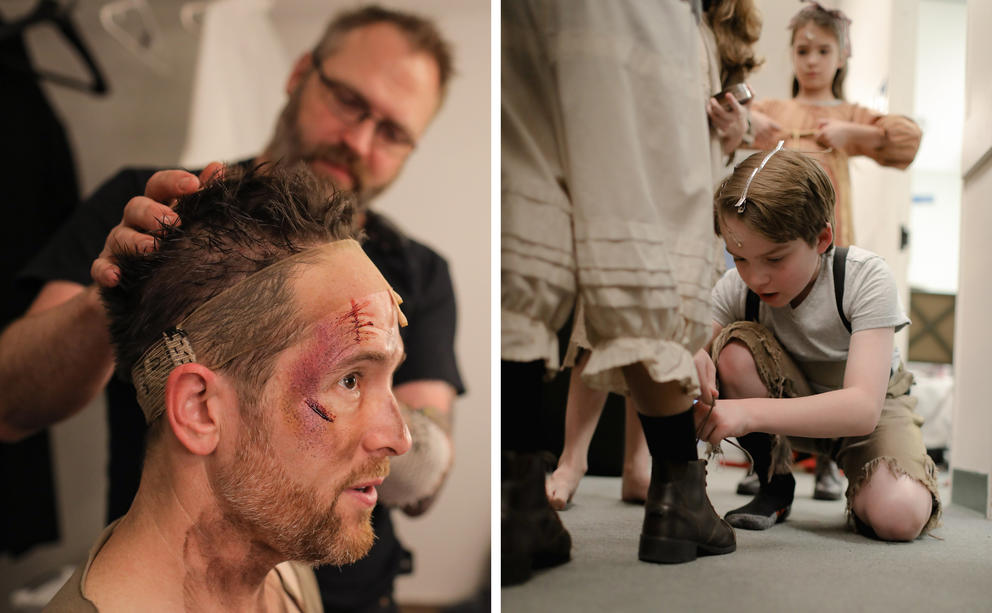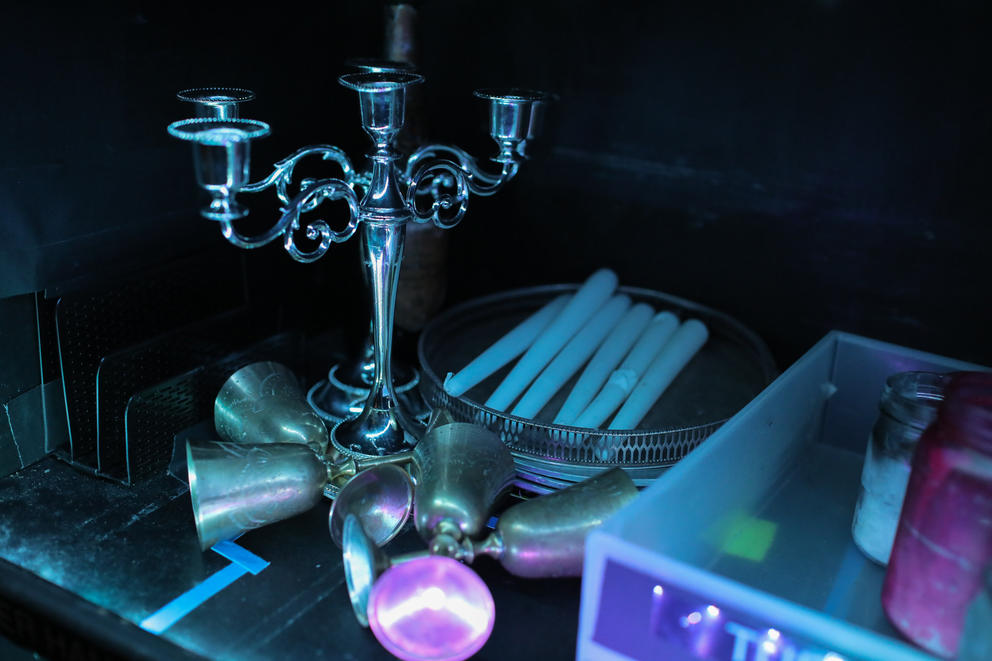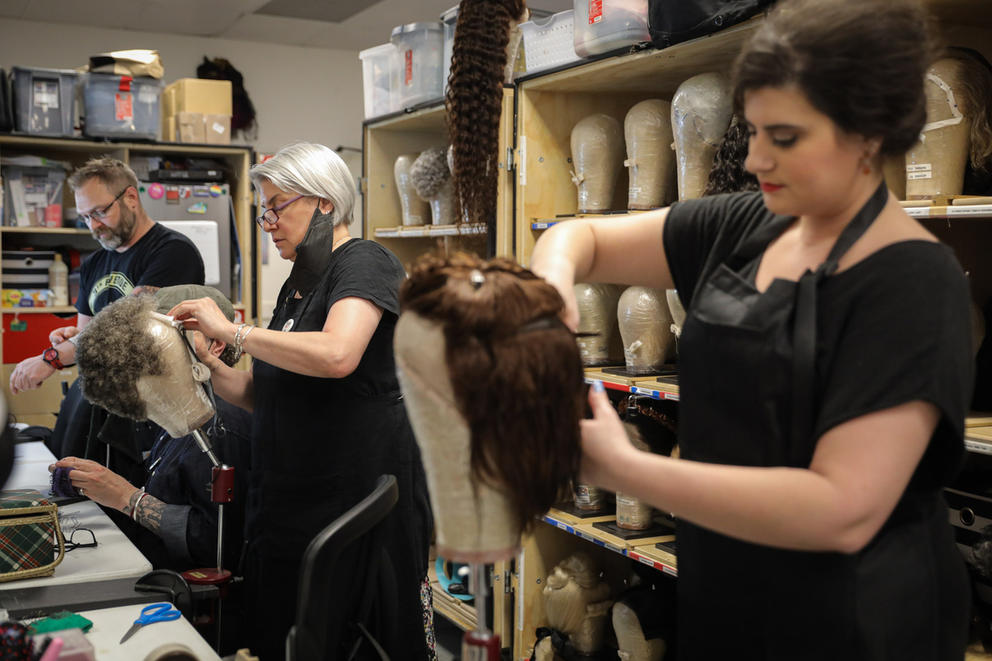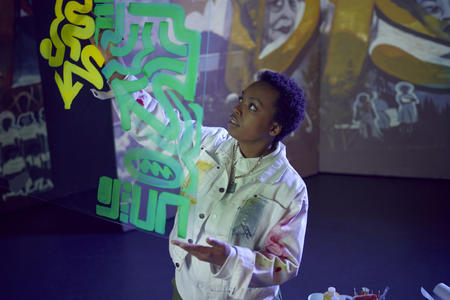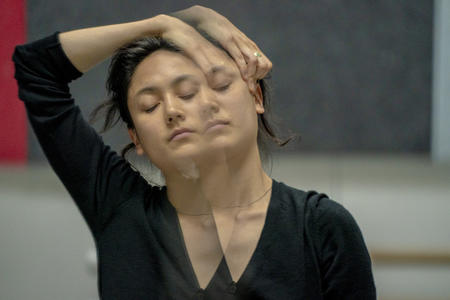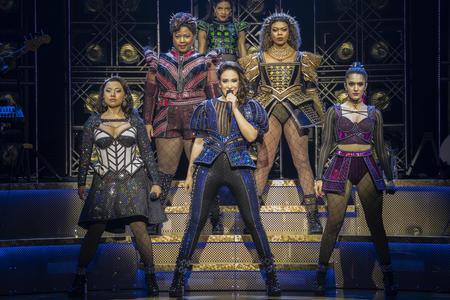Everyone behind the scenes is in motion: Stagehands lay out fake birds, candelabras, chains and other props as neatly as possible for easy access; a makeup artist artfully smudges dirt on the faces of 19th-century peasant children; and a stylist fits a wig on star character Jean Valjean (Nick Cartell) — already made up to look like a bruised and battered prisoner.
The small upstairs city known as “wardrobe village” is abuzz. Dressers carefully stack costumes for police, students and peasants so cast members can change personas between scenes.
In an adjacent room, stylists cut and heavily hairspray era-appropriate French wigs on mannequin heads, perfecting them for convict-turned-rich-man Valjean, upright police officer Javert (Preston Truman Boyd), student revolutionary leader Enjolras (Devin Archer) and other players.
Jack McLeod, production stage manager for the U.S. national tour of Les Misérables, addresses the cast and crew through his microphone. “Places call, this is our places call for the top of the show.”
The maestro runs down to the orchestra pit and actors — dressed as rugged convicts — situate themselves on stage in the dark. They lie in wait, ready for the opening number, “Work Song,” the hammering chain-gang song that introduces French peasant Valjean and gives us the backstory of his conviction. Haze and fog machines cast the stage in a ghostly aura, transporting the audience to 1815 Paris.
The show’s tagline, “still the world’s most popular musical,” is hard to prove but rings true: The live production of Les Misérables has been seen by more than 130 million people worldwide. In Seattle, it’s running at The 5th Avenue Theatre through June 17, and has proven to be one of the venue’s all-time best-selling shows, second only to holiday productions (which usually run two weeks longer than this run of Les Mis).
The beloved redemption story of Valjean continues to resonate with audiences, decades after its 1980 premiere in France and more than a century since Victor Hugo published his 1862 novel of the same name.
McLeod, a stage manager for 35 years, understands why. He says it’s his favorite show to work on.
“The story is so rich,” he says. “I can’t help but draw the comparisons to today.” With its emphasis on the overcriminalization of society’s most disadvantaged people, Les Mis continues to resonate with current conversations about ways to solve social issues beyond jail time.
For those unfamiliar with the story, it follows a man named Valjean, unfairly imprisoned for stealing a loaf of bread, who breaks parole, assumes a new identity and becomes rich. After promising to raise a prostitute’s daughter (Cosette, played by Addie Morales) as his own, he becomes engaged in various entanglements including student protests calling for revolution.
It’s quite a production, one that includes a 12-foot-tall barricade and a high, rolling staircase. Every element — from the elaborate costumes to image projections to the music — must be perfect to achieve full immersion in turbulent 19th-century France.
McLeod is positioned just offstage, in a corner where he has everything he needs to make sure the show runs smoothly: nine monitors showing different parts of the stage from various angles, as well as the orchestra pit and the front of house; a control panel with 12 switches to control things such as cue lights and sounds; and a thick binder containing the musical score annotated with reminders, which he flips through as the show progresses.
He does this almost every day — sometimes multiple times a day. McLeod has been with the touring show since October, with dates booked through August 2024. The 5th’s run alone contains 32 performances. But McLeod says it’s important to treat each show as an individual performance, because this particular audience will exist only for one night.
“Have a good show, everyone,” he says, broadcasting via headset. All 80 members of the touring cast and crew are in place, whether on stage, in the pit poised to play the gruff strains of “Work Song,” or backstage, ready to move sets and props.
For the seated audience, it’s showtime. The fog dissipates to reveal the chain gang on stage. Valjean is released from prison, but is unable to find work due to his convicted status. After being shown compassion by the Bishop of Digne (Randy Jeter), Valjean decides to lead a better life and revamp his identity.
Now the musical really gets rolling. Ensemble characters playing the peasant Parisians start to head onstage, a few of them fist bumping crew members in a message of good luck. Two people even have a practiced handshake routine with patty-cake motions, their palms meeting each other upright and upside down.
When McLeod switches the cue lights on and off, the technical crew moves props including tables and birdcages on and off stage, stealthy as cats.
As costume changes are required — such as when ensemble peasants switch roles to police officers — the actors don’t have time to go upstairs to wardrobe village. Instead, they change immediately backstage, swapping torn peasant shirts for elegant police uniforms.
Laundry baskets are positioned to accept their previous costumes, and dressers are available to help them button into jackets or fasten into corsets. During these brief pauses they take much needed sips of water from 21st century bottles.
Surprisingly, given the grandeur of the hall, the backstage at The 5th is quite small, made up of narrow hallways and staircases. So when it comes to storing the multitude of large set pieces, the crew has to get creative.
Large pieces — such as the runaway cart that Valjean lifts to save a trapped man early on the show and the railings of the bridge Javert jumps off to take his own life — hang from the high ceiling on industrial hooks attached to ropes. When it’s time to use them on stage, the tech team works slowly and quietly to retrieve them, with one crew member pulling the rope and others holding the prop as it comes down. The goal: Hit the ground noiselessly.
Take, par example, one of the most important set pieces in the show: the rolling staircase that shows up in multiple scenes. During “Lovely Ladies,” when Cosette’s mother Fantine (Haley Dortch) has no choice but to prostitute herself, the staircase is where an array of French women dressed in revealing, dirtied dresses call out for male suitors. Beforehand, the characters must all move into place on the staircase backstage. Once their cue hits, the crew rolls them out and immediately they’re in character, singing with gusto and gyrating suggestively.
The staircase appears again when the greedy Monsieur and Madame Thénardier (Matt Crowle and Christina Rose Hall) rob their inn’s guests during “Master of the House.”
As the show goes on, we learn that the only government employee who is sympathetic to the poor, General Lamarque (who does not appear on stage), has died. This sparks the student freethinkers to initiate an uprising in hopes of starting a new French revolution. When his death is announced in “Do You Hear the People Sing?” it’s a signal to the backstage crew that it’s time to build the barricade.
To prepare, the tech crew starts to bring props down from on high and gather those laid out below, reusing bits and pieces of props and sets utilized earlier in the show — staircases, barrels, bullet boxes — to create the large pile.
It’s tricky. The tight timing means the barricade must be pieced together backstage during especially quiet songs: “In My Life,” a duet between Cosette and Valjean, in which Cosette reveals her love for student rebel Marius (Gregory Lee Rodriguez) and asks her father why he is so secretive; and “A Heart Full of Love,” a romantic ballad between Cosette and Marius with interjections from a heartbroken Éponine (Christine Heesun Hwang), a peasant rebel who is also in love with Marius.
It would be a bad time to drop a handrail or knock over a box of bullets.
Luckily there’s a strategic break during intermission, when the crew finishes making the barricade. Then in Act 2, the crew must silently move the hulking, convincing barricade into place.
The audience won’t see it revealed until Éponine has finished her solo, “On My Own,” about her romantic yearning. At that moment, what appears to be a solid wall behind her opens up like double doors to reveal the barricade facing the audience. Éponine staggers back in awe, as if she too might be in thrall of the theater magic.
On stage the students are armed and poised to fight. A police officer is heard but not seen, melodically warning the rebels to stand down. It’s a loud, projected voice — almost as if through a megaphone. But in fact, the actor who plays the officer (Jeter, who also plays the Bishop and the student rebel Lesgles) is in the back, right behind stage manager McLeod, singing into a desktop microphone: “You at the barricade listen to this! / No one is coming to help you to fight! / You're on your own / You have no friends / Give up your guns or die!”
Doing double duty at this moment, Jeter is still in costume as one of the student rebels. After singing the lines of his character’s enemy, he slips back onstage, an outraged student once again.
It’s time for the climax of the story, the brutal battle at the barricade between student revolutionaries and the French army. Spoiler alert: It’s a massacre that only Valjean and Marius (with Valjean’s assistance) survive.
At one point in the action, student leader Enjolras falls over the top of the barricade after being shot. It’s an emotional moment, but less tragic as witnessed on McLeod’s backstage monitor, where you can see him fall onto a hidden mattress. The smoky, chemical smell of the custom-designed theatrical “live fire” guns seeps backstage.
The barricade is rolled off stage. As soon as the “dead” students are out of sight, they jump or climb down and hang back until their next scene, when they’ll visit Marius as ghosts during the mournful, tragic number “Empty Chairs at Empty Tables.”
There are still a few more scenes to be had in this three-hour spectacle — Javert’s suicide and Marius and Cosette’s wedding — before at last we reach the end: Jean Valjean’s death scene.
The final song, “Do You Hear the People Sing? (Reprise)” happens with Valjean on his deathbed. Soon the ghosts of Fantine, Éponine, the Bishop and the student rebels arrive to welcome the long-suffering hero into heaven. Valjean asks for forgiveness and then the cast asks the audience, in this poignant and reflective moment, “Will you join in our crusade? / Who will be strong and stand with me?”
But you won’t hear any answers backstage, where McLeod has already started wishing everyone a good night, reminding them of the call time for the next day.
Get the latest in local arts and culture
This weekly newsletter brings arts news and cultural events straight to your inbox.

